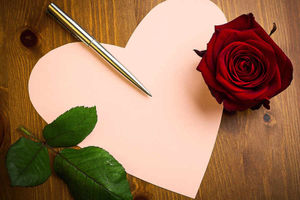x (p + b + c + o) - The formula for the perfect love poem
Did you struggle to know what to give your loved one for Valentine's Day? Did you give them a love poem? Or did the knowledge that you're not a poet put you off? Kirsty Bosley teamed up with poetry expert Julia Bird so you'll know how to craft the perfect verse for next year.

When you think of romance, what springs to mind? Chocolates and flowers? Kisses by candlelight?
As a bunch of avid readers, you can imagine that a love poem is a sure-fire way to any of the Weekend team's hearts.
But penning the perfect verse is an entirely different story altogether. So we've brought in the experts to help us impress the Weekend WAGs and bag our dream blokes.
Julia Bird is a professional poet and member of the UK Poetry Society. She's teamed up with one of the most romantic businesses in the world, floristry network Interflora, to encourage more people to write.
Who better to help us become perfectly poetic wily wordsmiths?
Julia began by analysing the nation's favourite 10 love poems to develop a formula for the perfect romantic verse, and it's this simple:
x (p + b + c + o)

Yes, our faces were doing that too. Just like the course of love, the course of poetry writing never did run smoothly. So, here's the formula, explained:
P = Pattern. All 10 of the nation's favourite love poems are boldly metrical and have strong rhyming patterns. Rhythm is important to the love poet – it puts the reader in mind of heartbeats and dance steps. A rhyming couplet asserts a truth like no other figure of speech. Pepper your poems with pattern.
B = Brevity. Many of the poems on the lists are sonnets – from Shakespeare's 'Let me not to the marriage of true minds' to Elizabeth Barrett Browning's 'How do I love thee? Let me count the ways'. Your flower card provides even less space than the 14 lines of a sonnet, so you'll want to make your point in a very few words – those words that your lover can recite by heart for the rest of their life.
C = Comparison. 'Shall I compare thee to a summer's day' asks Shakespeare, and Robert Burns answers 'O my Luve's like a red, red rose'. The desire to compare and describe the love is a common thread through love poetry. What's your love like? Why, s/he's like something else.
O = Obstacle. 'The course of true love never did run smooth' says Lysander in A Midsummer Night's Dream. Many of the nation's favourite love poems examine the difficulties inherent in a love affair, from Yeats' poverty in 'He Wishes for the Cloths of Heaven' to Andrew Marvell lacking world enough and time in 'To His Coy Mistress' to Christina Rossetti's imminent death in 'Remember'. What obstacle will you overcome in order to impress your soul mate?
X = Mystery Quality. Finally, multiply all these necessary ingredients of a love poem by the passion, creativity and detail that only you can provide when you're contemplating your particular best beloved. X also symbolises a kiss, and you'll want to finish your message with any amount of those.'
So now we know this, how do we put it all together to write the perfect poem?
Julia says: "There are eight tips to crafting the perfect verse. Read first, then write. Poets have wooed their lovers in verse for centuries, poetry is a continuous conversation that you can join. Read a few of the best love poets for inspiration, and see what classic works you can adapt or imitate for your own romantic purposes.
"Alternatively, you could always quote someone else's poem on your flower card. The website poetryarchive.org contains thousands of poems celebrating every sort of idea and experience, and you can search by keywords to find something particularly meaningful to you and your lover.
"Remember, specificity is key. If you're going to write a poem about your partner, don't try and encompass the whole sweep of your relationship – focus on the particular detail: the weather on the day you met, the charming asymmetry of her freckles, the way he cooks shepherd's pie. There's nothing so disarming as the knowledge that you are deeply known and remembered by another.
"Equally exciting, however, is mystery. Perhaps you're sending your flowers anonymously. In that case, concentrate on describing your own feelings – are you yearning or burning, sighing or lying? The person on the receiving end of the dozen stargazers will be dizzy with curiosity about who they've inspired to such levels of emotion.
"Love poetry is driven by rhythm, the pattern of words that makes readers think of heart beats or dance steps. Are you going to fit lots of multisyllabic Latinate words into your lines for a delicate and precise sound; or will you go for the pounding rhythms of shorter Anglo Saxon words? A rose is the same thing as a Rosa berberifolia – but which one is more like your particular crush?
"If you're using rhyme, look beyond the obvious full rhymes (love/dove, heart/apart, moon/June) that have been used many times before. Part rhymes (love/save, heart/hurt, moon/mine) are less predictable, therefore more intriguing.
"Leave behind the language of the past. Some poetic phrases are woven so deeply into our culture ('Shall I compare thee to a summer's day'/'What light through yonder window breaks') that we reach instinctively for the archaic poem-sounding words to add gravitas to our writing. Let go of 'thee' and 'yonder', and instead find the poetry in the fads and fashions of today's dictionaries.
"Your innate creativity. Your relationship, fuelled by its particular mix of emotion, memory, desire, laughter and regret. The passion that you have for her, the lust that you have for him. Find a place for it all in your writing. Let your poem bloom."
Now we've got all of this nailed down, how do we plan on romancing our significant others?
Well, we're off to buy them a copy of a Julia Bird poetry book, of course.





